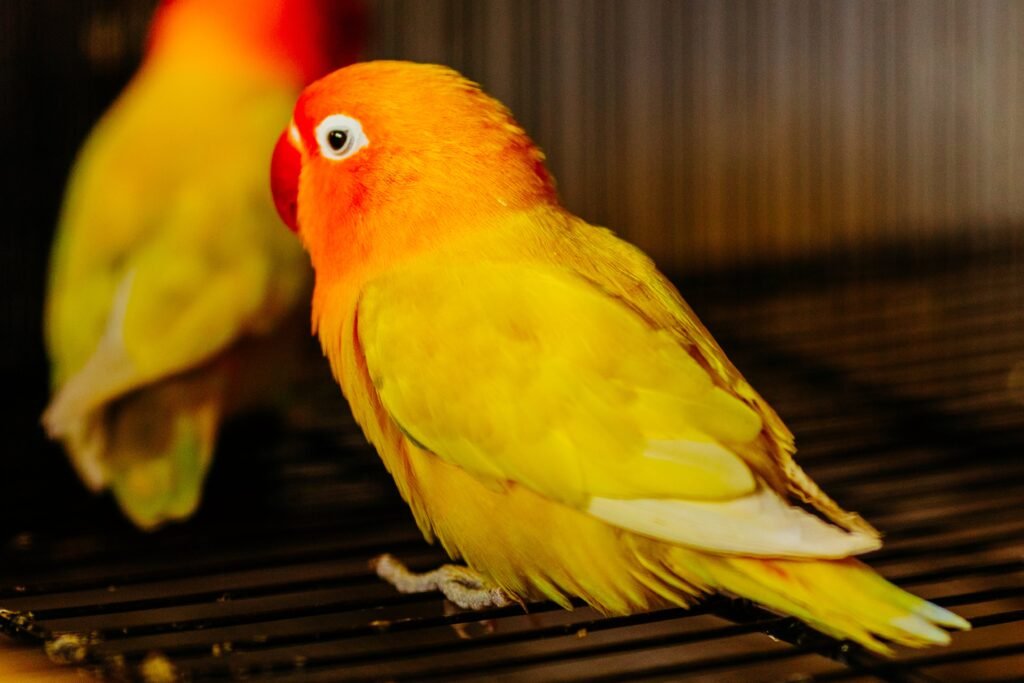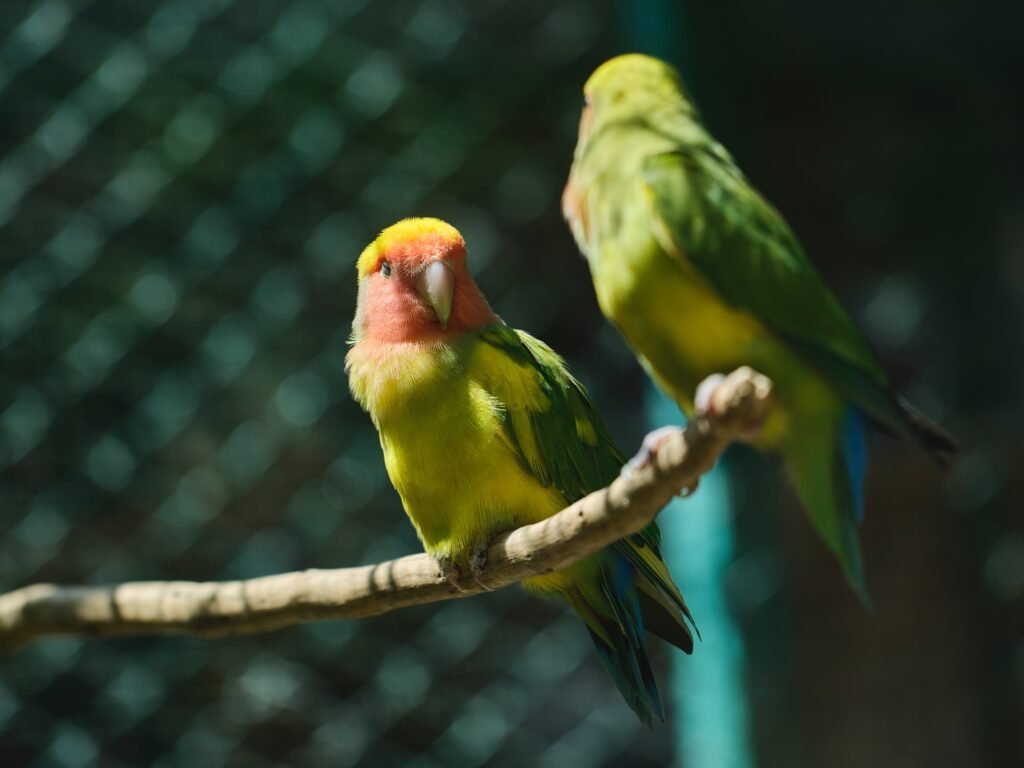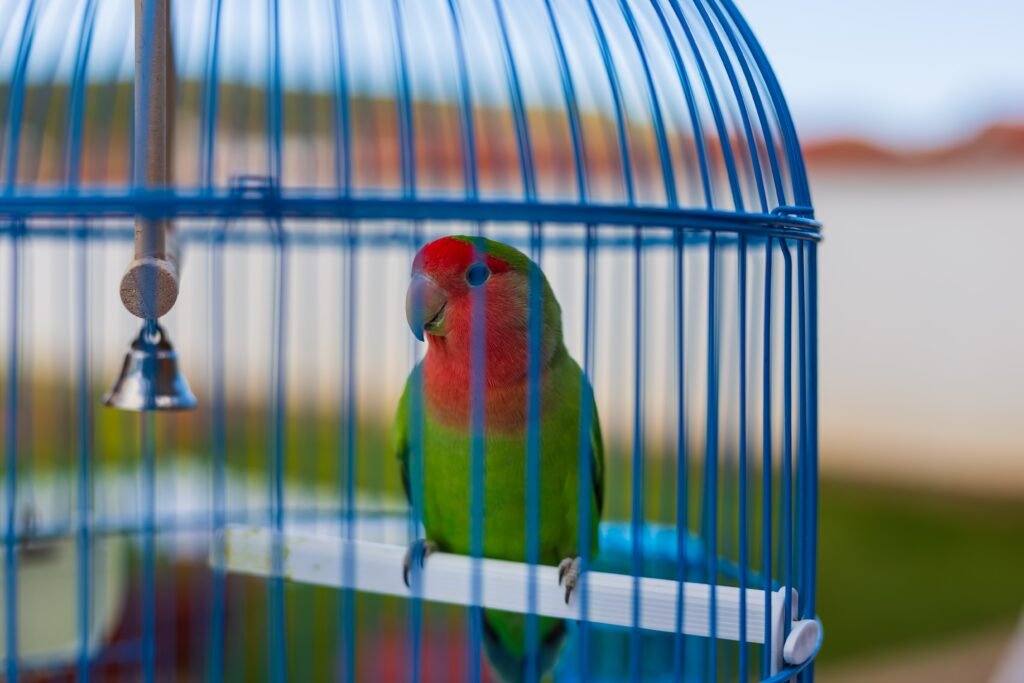
Lovebirds are small, colorful parrots known for their affectionate nature and striking appearance. These delightful birds are native to Africa and belong to the genus Agapornis, which translates to lovebird in Greek. Lovebirds have become popular pets among bird enthusiasts with their vibrant plumage and endearing behavior. In this article, we will explore the physical characteristics, colors, and various species of lovebirds to comprehensively understand what these lovebird bird look like.
Physical Characteristics
Lovebirds are small birds, typically measuring 5 to 7 inches long. They have a stocky build and a short, rounded tail. Their strong beaks are designed for cracking seeds and nuts, which form a major part of their diet.
One distinct feature of lovebirds is their hooked beak, which aids in climbing and manipulating objects. Their feet are designed for perching, allowing them to easily grip onto branches and other surfaces. Lovebirds have a unique ability to move their upper and lower mandibles independently, enabling them to easily crack open seeds.
Their short and rounded wings allow them to maneuver quickly through dense vegetation. Lovebirds have a strong flight but are more inclined to hop and climb rather than fly long distances. They are agile and acrobatic, often hanging upside down from branches and curious about their surroundings.
Colors and Feather Variations
Lovebirds are known for their stunning array of colors. While their body shape remains relatively similar across different species, the colors and patterns of their plumage can vary greatly. Some of the common color mutations seen in lovebirds include:
- Lutino: These lovebirds display a striking yellow coloration with red eyes. Their vibrant yellow feathers make them stand out among other lovebird species.
- Albino: Albino lovebirds lack melanin pigment, resulting in pure white plumage and pink eyes. Their unique appearance gives them an ethereal and delicate beauty.
- Pied: Pied lovebirds feature a mixture of colors, with patches or spots of white on their bodies. This variation creates a mosaic-like pattern, making each bird visually distinct.
- Cinnamon: Cinnamon lovebirds have a warm brown coloration with a cinnamon-like hue. Their feathers exhibit a rich, earthy tone that adds a touch of warmth to their appearance.
- Opaline: Opaline lovebirds exhibit a pastel coloration, often combined with other color mutations. Their feathers are soft, almost iridescent, giving them an enchanting and delicate look.
It’s worth noting that the specific colors and mutations can vary depending on the lovebird species. Each color mutation adds a unique touch to the overall appearance of these charming birds.
Lovebird Species
Lovebirds are classified into nine species, each with unique physical characteristics and colors. These species include:
- Fischer’s Lovebird: Fischer’s lovebirds are known for their vibrant plumage, which consists of green, red, and yellow feathers. They have a distinct white ring around their eyes, which adds to their captivating appearance.
- Masked Lovebird: Masked lovebirds are primarily green, with a black mask-like marking over their face. They have a blue rump and tail, providing a beautiful contrast to their green body.
- Peach-faced Lovebird: Peach-faced lovebirds are named after their peach-colored face and neck. They have a green body and a blue tail, creating a stunning color combination.
- Black-cheeked Lovebird: Black-cheeked lovebirds have predominantly green plumage with a black cheek patch and a blue rump. The black cheek patch adds a touch of drama to their overall appearance.
- Nyasa Lovebird: Nyasa lovebirds are mainly green, with a red forehead and a blue rump. They have a distinct yellow collar around their neck, which sets them apart from other lovebird species.
- Red-headed Lovebird: As the name suggests, red-headed lovebirds have a bright red head with a green body. They also sport a blue rump and tail, creating a striking color combination.
- Black-collared Lovebird: Black-collared lovebirds have a green body with a black collar around their neck and a blue rump. The black collar adds a touch of elegance to their appearance.
- Grey-headed lovebirds have a grey head, green body, and a blue rump. Their unique color combination gives them a sophisticated and refined look.
- Abyssinian Lovebird: Abyssinian lovebirds are predominantly green, with a yellow face and a blue rump. Their vibrant yellow face adds a pop of color to their overall appearance.
Each lovebird species has unique charm and characteristics, making them fascinating pets for bird lovers. The diversity of colors and patterns among lovebird species ensures a lovebird that suits every aesthetic preference.
Personality and Behavior
Apart from their physical appearance, lovebirds are renowned for their affectionate behavior. These social birds form strong pair bonds and are often seen cuddling or preening each other. They enjoy spending time with their human companions and can become quite attached.
Lovebirds are highly intelligent and curious creatures. They thrive on mental stimulation and require regular interaction and enrichment to prevent boredom. Providing them various toys, puzzles, and foraging opportunities is essential to keep their active minds engaged.
In addition to their affectionate nature, lovebirds are known for their playful antics. They enjoy exploring their environment, hopping from one perch to another, and engaging in acrobatic displays. Lovebirds are natural climbers and enjoy hanging upside down from toys or cage bars.
It’s important to note that lovebirds can be territorial, especially during breeding season. They may behave aggressively towards other birds or become possessive of their cages. Providing them with adequate space, toys, and attention can help alleviate any potential behavioral issues.
Conclusion
Lovebirds are visually striking birds with their vibrant plumage and endearing nature. From the various species and color mutations they possess to their playful behavior, lovebirds make wonderful pets for bird enthusiasts. Whether captivated by their colorful appearance or charmed by their affectionate personality, lovebirds will surely bring joy and companionship into your life.
So, if you’re considering adding a lovebird to your household, be prepared for a delightful companion that is as beautiful on the outside as they are on the inside. Their small size, striking colors, and affectionate behavior make them a popular choice for novice and experienced bird owners. With proper care, lovebirds can live long and fulfilling lives, providing endless entertainment and love to their human companions.
FAQ
Q: What is the average size of a lovebird?
A: Lovebirds are typically around 5 to 7 inches in length.
Q: What are the unique physical characteristics of lovebirds?
A: Lovebirds have a stocky build, short, rounded tail, hooked beak, and feet designed for perching. They also have short and rounded wings for quick maneuvering through vegetation.
Q: What are some common color mutations seen in lovebirds?
A: Some common color mutations in lovebirds include Lutino (yellow with red eyes), Albino (pure white with pink eyes), Pied (mixture of colors with white patches), Cinnamon (warm brown coloration), and Opaline (pastel coloration).
Q: How many species of lovebirds are there, and what are their unique physical characteristics?
A: There are nine different species of lovebirds. Each species has its unique physical characteristics and colors. Some examples include Fischer’s Lovebird (vibrant plumage with white eye ring), Masked Lovebird (black mask-like marking over the face), and Peach-faced Lovebird (peach-colored face and neck).


